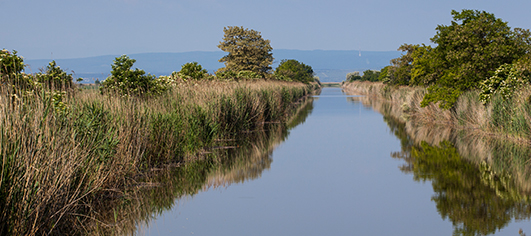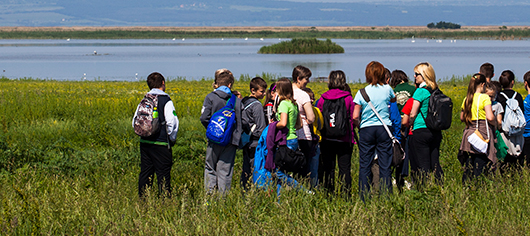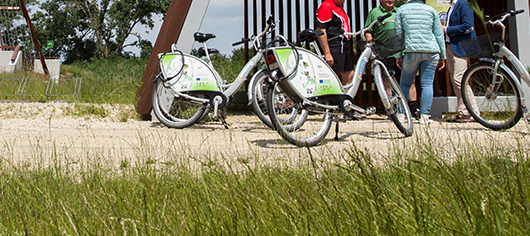The 4 priorities
In thematic terms the support of the programme Interreg V-A Austria-Hungary concentrates on four cooperation areas, the so-called priority axes, whereat each priority axis contains specific objectives.me region.
To obtain support for a cross-border project, it shall fit in the pre-defined priority axes and specific objectives of the programme as well as in the respective activity fields. Detailed information about the priority axes with a description of possible actions can be found on the following pages or in the respective brochures on the concrete topic.
Competitive
The Austrian-Hungarian border region has already strong centres of R&D activities. However, these are concentrated in the urban agglomerations like Wien or Graz. Moreover, the regional SMEs lack access to R&D-results and to funds for innovation. And additionally, there is a considerable innovation gap between the Hungarian and the Austrian part of the programme region.
At the various intermediate organisations in both countries that support SMEs the effectiveness varies throughout the border region and their cross-border cooperation is mainly based on projects.
So there is need for action, which the programme intends to cover with own measures.
Sustainable
The Austrian-Hungarian border region is a historically grown cultural landscape with rich natural and cultural heritage that attracts both national and international guests. Most of the region’s cultural and natural heritage is under protection, while its valorisation for green tourism lags behind. This is where cross-border cooperation can make an important contribution by developing joint organisational structures and by coordinating, planning and implementing joint actions. Jointly developing and valorising these assets bears great potential for the region’s economic and social development, especially in the rural parts.
Moreover, the border region possesses a high biodiversity and a wide range of valuable eco-systems, of which many, but not all are protected. However, growing land consumption related to infrastructure investments and economic development of the region, as well as effects from climate change jeopardize the region’s natural wealth. Thus, the protection, connection and extension of natural habitats are of vital importance.
National and nature parks, Natura 2000 sites and other protected areas have already established successful networks and show a great interest to continue their current cooperation in the future.
The Austrian-Hungarian border region is characterized by strongly integrated groundwater bodies and border crossing water courses. Therefore, joint water management and flood prevention is absolutely essential, and it comes as no surprise that cross-border cooperation in these issues has a long tradition in the border region: the Austrian-Hungarian Water Commission coordinates all activities around border water courses since 1956. Continuation of cooperation is required to maintain and further improve the high quality of protection and sustainable use of the natural resources. Furthermore, the point is to reduce natural risks in the field of water management, to optimise flood protection and to prepare for potential climate change impacts. There is a particular need for better coordination of environmental protection and flood risk management along the rivers Raab/Rába and Leitha/Lajta.
Accessible
In terms of transport the Austrian-Hungarian border region is characterised by the core network corridors of the Trans-European Transport Networks (TEN-T) being located on the northern, western and southern fringes of the programme region. The comprehensive network runs in close distance and almost parallel to the border on the Hungarian side of the Austrian-Hungarian border region. By re-building and complementing border-crossings, regional centres (tertiary nodes) in Burgenland, which currently do not have a connection to the TEN-T network, shall be connected to the corridor in Hungary.
Despite the fact that quite some efforts have been made in the last years in order to provide competitive alternatives of environmentally friendly transport services, the private car still is the dominant means of transport on both sides of the border. In order to increase the share of people using sustainable means of transport all planned infrastructure investments have to be accompanied by a set of additional measures for the improvement of environmentally friendly transport.
Connected
The Austrian-Hungarian border region is characterised by different legal and institutional frameworks in both countries, which in many cases negatively affect the preparation and implementation of cross-border activities. However, well established and coordinated regional governance structures are a crucial precondition for making best use of existing resources in the cross-border context.
This challenging situation concerns also topics, in which problems can solely or at least better be solved by cross-border approaches. This again clearly shows the need for action and the starting point for the programme.
Furthermore, the strong demand by stakeholders being active in education and (vocational) training shows the high regional potential of these topics. The need for action for the programme derives from the fact that cooperation in this fields, especially in the cross-border context, depends to a large extent on the abilities and mind-sets of individuals. Therefore, this specific objective aims to improve the pre-requisite of cross-border cooperation by supporting language initiatives as well as intercultural and joint trainings.










